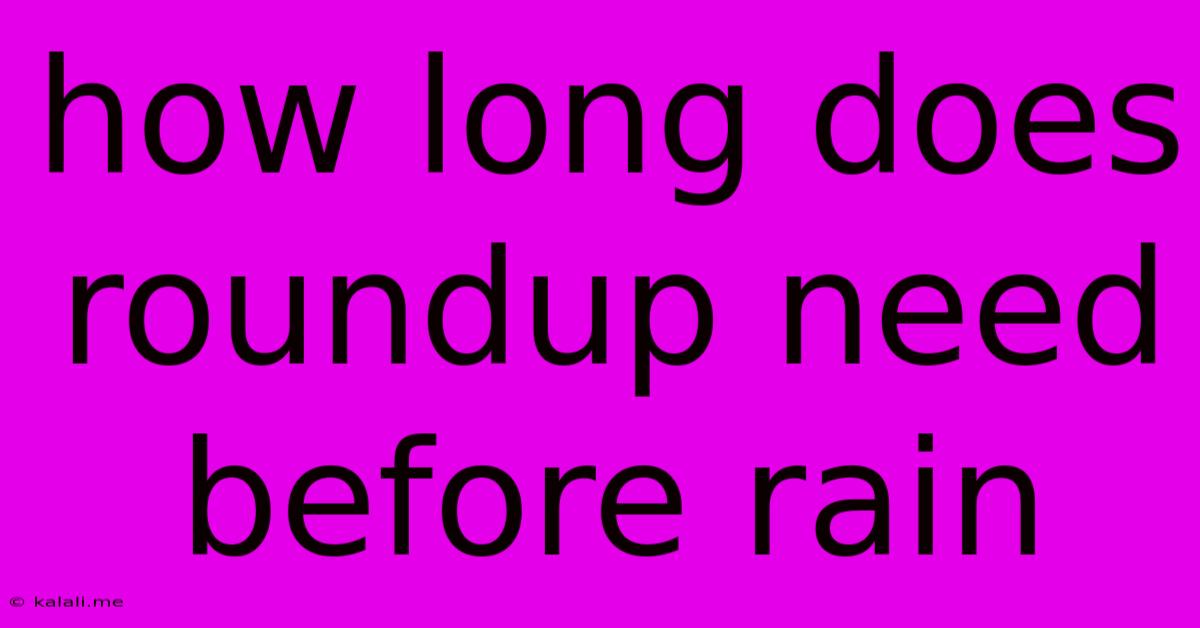How Long Does Roundup Need Before Rain
Kalali
Jun 01, 2025 · 2 min read

Table of Contents
How Long Does Roundup Need Before Rain? A Comprehensive Guide
Meta Description: Worried about rain washing away your Roundup application? Learn how long you need to wait after spraying Roundup before rain, plus tips for maximizing effectiveness and minimizing environmental impact.
Rain can significantly impact the effectiveness of Roundup (glyphosate) weed killer. Understanding how long to wait before rain is crucial for achieving optimal results and preventing wasted effort. This guide explores the timeframe needed, influencing factors, and best practices for using Roundup in various weather conditions.
Understanding Roundup's Mechanism
Roundup works by absorbing into the leaves and stems of plants, eventually reaching the roots. This process takes time, and rain washing away the herbicide before sufficient absorption can reduce its efficacy. Glyphosate needs time to translocate within the plant. This translocation is the movement of the herbicide from the leaves to other parts of the plant, including the roots, which is essential for complete eradication.
The Crucial Waiting Period
While there's no universally applicable timeframe, a general guideline is to wait at least 2-4 hours after application before expecting rain. This allows the Roundup to adhere to the plant's foliage and begin the absorption process. However, several factors influence this waiting period:
- Rainfall intensity: A light drizzle might have less impact than a heavy downpour.
- Plant type: Some plants absorb Roundup faster than others. Larger, thicker-leaved plants might require a longer waiting period.
- Roundup formulation: Different Roundup formulations might have slightly varying absorption rates. Check the product label for specific recommendations.
- Temperature and humidity: Higher temperatures and humidity can accelerate absorption, potentially shortening the waiting period.
Maximizing Roundup Effectiveness in Rainy Conditions
While waiting for ideal conditions is best, you can take steps to mitigate the effects of rain:
- Spray early in the day: This allows the plants to dry before nightfall, reducing the risk of the herbicide being washed away.
- Choose a less windy day: Wind can blow the spray away from the target plants, reducing effectiveness.
- Apply Roundup at the correct concentration: Following the instructions on the product label is paramount.
- Consider alternative methods: If rain is consistently predicted, consider alternative weed control methods, such as hand-weeding or using a different herbicide with rain resistance properties.
Environmental Considerations
Always follow the manufacturer's instructions and take precautions to protect the environment. Avoid spraying near water bodies and be mindful of wind direction to prevent herbicide drift. Proper disposal of empty containers is also essential.
Conclusion
Waiting for suitable weather conditions is crucial for optimizing Roundup effectiveness. While a 2-4 hour waiting period is a reasonable guideline, several factors can influence this. By understanding these factors and implementing best practices, you can maximize your results while minimizing environmental impact. Remember to always consult the product label for specific instructions and safety precautions.
Latest Posts
Latest Posts
-
Many Are Called But Few Are Chosen Meaning
Jun 03, 2025
-
How To Change Bulb On Recessed Light
Jun 03, 2025
-
Can Stainless Steel Cookware Go In The Oven
Jun 03, 2025
-
Kirby And The Forgetton Land Coins
Jun 03, 2025
-
Why Was John The Baptist In Prison
Jun 03, 2025
Related Post
Thank you for visiting our website which covers about How Long Does Roundup Need Before Rain . We hope the information provided has been useful to you. Feel free to contact us if you have any questions or need further assistance. See you next time and don't miss to bookmark.